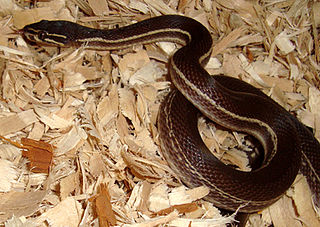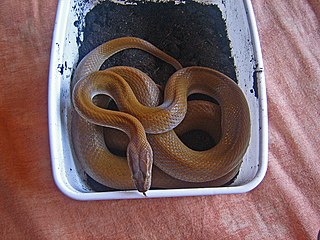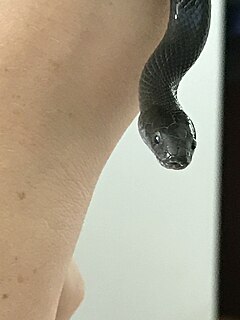
Lamprophis is a genus of medium-sized, nonvenomous snakes commonly referred to as African house snakes.
Chamaelycus is a genus of snakes, commonly referred to as banded snakes, in the family Lamprophiidae. The genus is endemic to Central Africa.
Hormonotus is a genus of snakes. At present, this genus is monotypic, as there is only one commonly accepted species in it, Hormonotus modestus, commonly known as the Uganda house snake or yellow forest snake. It is widespread in tropical Africa. Its sister taxon is Inyoka swazicus, the Swazi rock snake.

Mehelya is a genus name of colubrid snakes from Africa. Some species formerly assigned to the genus Mehelya are now found in the genera Gonionotophis, Gracililima, or Limaformosa. They are collectively called file snakes due to their unusual scalation. They are not venomous.

Lycodonomorphus is a genus of snakes commonly referred to as African water snakes. They are small, nonvenomous snakes, with all members being endemic to Africa, especially Tanzania.
The Cape file snake is a species of large, non-venomous snake endemic to Africa, belonging to the family Lamprophiidae.

Boaedon is a genus of African lamprophiids consisting of the "brown" house snakes. The genus was originally described by Duméril but the species contained were reclassified as Lamprophis by Fitzinger in 1843, this taxonomy remained widely accepted until November 2010 when a phylogenetic study was published by C.M.R Kelly et al. who resurrected the Boaedon clade. Although commonly regarded as belonging to the Colubridae, primary literature usually lists them, and related species, as belonging to the family Lamprophiidae within the superfamily which includes the venomous cobras and mambas, Elapoidea.
Inyoka is a monotypic genus of southern African snakes. The word "inyoka" means "snake" in Zulu, Xhosa, Swahili, Shona and other African languages. These snakes were previously grouped in the genus Lamprophis but were found to be closer related to Hormonotus; a substantial genetic divergence between them and a 1900 km gap between their geographic ranges meant a new genus was erected for Lamprophis swazicus, the sole species of the new genus.

Boaedon capensis, the Cape house snake, also known as the brown house snake, is a species of lamprophiid from Botswana, South Africa, Mozambique, Zambia and Zimbabwe. They are a non-venomous lamprophiid. This species was previously grouped in the genus Lamprophis but is regrouped with the genus Boaedon.

The Lamprophiidae are a family of snakes found mostly in Africa, but also in parts of southern Europe and western Asia. A few species reach southeastern Asia. There are 322 species as of April 2019.

Hemirhagerrhis is a genus of snakes in the subfamily Psammophiinae within the family Lamprophiidae.

Compsophis is a genus of harmless snakes in the family Lamprophiidae. The genus is found only on the island of Madagascar.

Prosymna is a genus of snakes of the family Lamprophiidae. It is the only genus in the subfamily Prosymninae.

Lamprophiinae is a subfamily of lamprophiid snakes, a large group of mostly African snakes, most of which were formerly classified as colubrids but which we now know are actually more closely related to elapids.

Lycodonomorphus inornatus, commonly known as the olive house snake, the black house snake, and the olive ground snake, is a species of nonvenomous snake in the family Lamprophiidae. The species is endemic to southern Africa. It is a nocturnal snake with terrestrial habits.

The black file snake, also known commonly as the dwarf file snake or the Nyassa file snake, is a species of snake in the subfamily Lamprophiinae of the family Lamprophiidae. The species is endemic to Africa.
Limaformosa is a genus of snakes, commonly known as file snakes, in the family Lamprophiidae. The genus is endemic to Africa.

Thamnosophis stumpffi, commonly known as the yellow-striped water snake, is a species of snake in the subfamily Pseudoxyrhophiinae of the family Lamprophiidae. The species is endemic to Madagascar.
Kladirostratus is a genus of snakes of the family Lamprophiidae. Members of this genus are known as Branch's beaked snakes.











